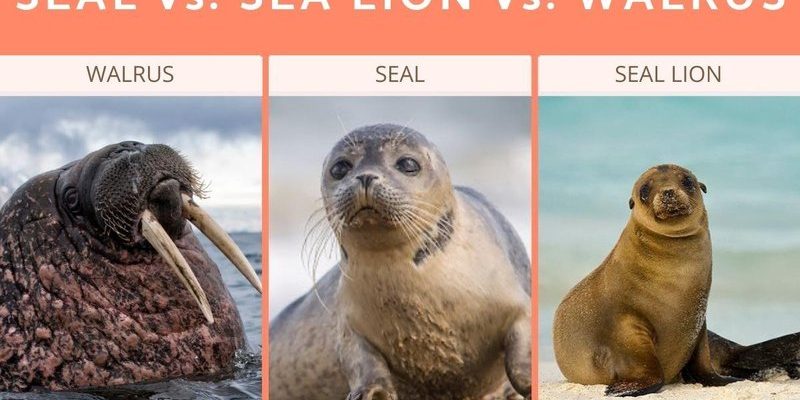![Sea Lion Vs. [Similar Species] - Key Differences](https://gudri.com/wp-content/uploads/2025/06/Sea_Lion_Vs___Similar_Species______Key_Differences_image_0.jpg)
Knowing how to distinguish between sea lions and seals can be surprisingly useful. Whether you’re visiting an aquarium, enjoying a day at the beach, or just curious about the natural world, understanding these differences makes your encounters with these animals more meaningful. So, grab your favorite beverage, and let’s unpack the unique traits of sea lions and their sleek, adorable relatives, seals.
Physical Differences: How to Spot Them
One of the most noticeable differences between sea lions and seals is their body shape and features. Sea lions are generally larger, with males reaching up to 800 pounds. Their robust bodies have a distinct, dog-like face, complete with external ear flaps. This feature is significant because seals, on the other hand, have smooth, rounded heads without visible ears. It’s like comparing a Labrador to a bulldog; both are adorable but easily identifiable at a glance.
Another physical trait to consider is their limbs. Sea lions have long front flippers that they use for swimming and can even rotate their back flippers, allowing them to walk on land more easily. Think of them as the acrobats of the ocean! In contrast, seals have shorter, more paddle-like flippers, which make them less agile on land. If you happen to see a sea lion lumbering up on a beach, it’s a funny sight—like a furry puppy on a mission!
Behavioral Differences: Social Habits
When it comes to socializing, sea lions are the life of the party. They often gather in large groups called colonies or rafts, where they bark and play together. Picture a bustling family reunion at a beach picnic—there’s noise, laughter, and plenty of activities going on. Sea lions are also known for their playful nature and can often be seen riding waves or leaping out of the water, just for fun!
Seals, however, tend to be more solitary or found in smaller groups. They communicate primarily through soft sounds, like grunts and whines, rather than the barking of sea lions. Imagine a cozy book club with a few close friends chatting quietly instead of a wild beach bash. While seals do come together for breeding, they often prefer to sunbathe alone, which gives them a more laid-back vibe.
Habitat Preferences: Where They Call Home
Sea lions are often found along the coasts of the Pacific Ocean, from California to South America. They love sandy beaches and rocky shorelines where they can bask in the sun and dry off. If you ever visit the famous Pier 39 in San Francisco, you’ll likely see sea lions lounging together like a bunch of beachgoers relaxing after a swim.
In contrast, seals can be found in a wider variety of habitats, including icy waters. Species like the harbor seal enjoy rocky shores, while others, like the Weddell seal, prefer the frigid Antarctic regions. So, if you’re a seal lover, you might find them in some of the most remote and chilly parts of the world, while sea lions stick to warmer, sunnier spots.
Dietary Differences: What’s on the Menu
Both sea lions and seals are carnivorous, but their diets can differ slightly. Sea lions are known to be opportunistic feeders, enjoying a mix of fish, squid, and sometimes even crustaceans. They’re like the adventurous eaters at a buffet, trying a bit of everything! Their hunting technique often involves group coordination, allowing them to herd fish into tight balls for easier feeding.
On the flip side, seals tend to be more specialized in their diets. Certain species might focus more on specific fish types or even rely on unique prey like mollusks or seals. It’s as if they have their favorite menu at a restaurant, sticking to what they know best. This specialization can sometimes make them more susceptible to changes in their environment, especially when food sources dwindle.
Reproductive Differences: How They Mate
When it comes to mating, sea lions are often quite the show-offs. Males will establish territories and try to attract females by barking and posturing, showcasing their impressive size and strength. It’s like a peacock spreading its feathers, all for the sake of love! Breeding usually occurs in large colonies, which can get pretty competitive and noisy.
On the other hand, seals tend to have more straightforward courtship rituals. After mating, female seals will often give birth to a single pup and nurse it for several weeks. They’re more focused on nurturing quietly compared to the bustling sea lion colonies. This contrast in their mating behaviors reflects their overall personalities—sea lions are the extroverts, while seals lean more toward introversion.
Conservation Status: Challenges Faced
Both sea lions and seals face challenges in the wild, but their conservation statuses vary. Sea lions, particularly the California sea lion, have seen their populations fluctuate due to environmental changes and human activities. While they are currently not listed as endangered, they are protected under the Marine Mammal Protection Act, which helps ensure their safety.
Seals, on the other hand, encounter different threats depending on the species. Some, like the Hawaiian monk seal, are critically endangered, facing risks from climate change, habitat loss, and human interactions. It’s a reminder of how interconnected we are with wildlife and how vital it is to protect their habitats for future generations.
Understanding the differences between sea lions and seals isn’t just about identifying them at the beach or in documentaries; it enriches your appreciation of the natural world. Whether you find yourself on a sunny shore watching sea lions frolic or peering at seals lounging on icy rocks, you can now appreciate the unique traits that make each species special.
So, next time you think about these marine mammals, remember they’re more than just cute faces—they have distinct lifestyles, habits, and histories worth knowing! Let’s cherish these incredible creatures and advocate for their continued protection in our oceans.

